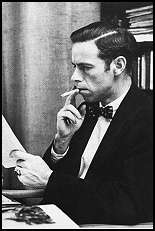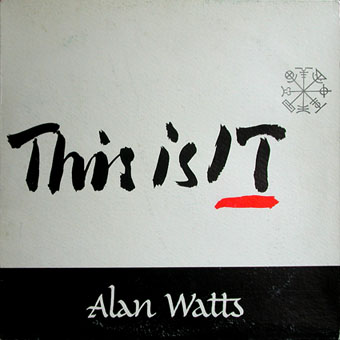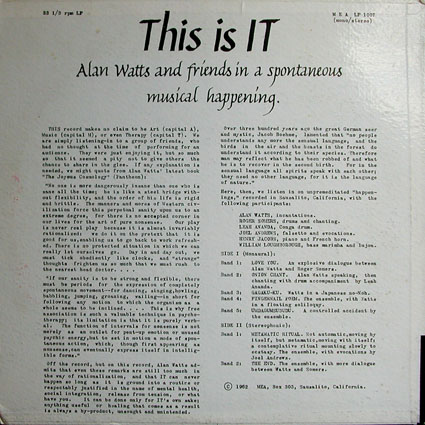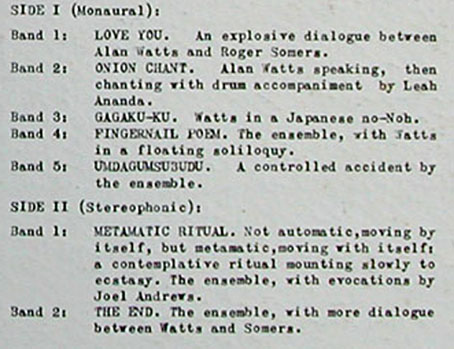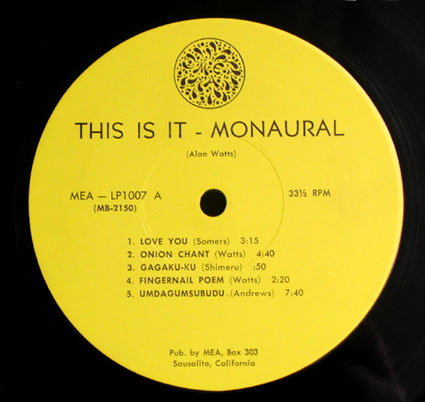THE FIRST
PSYCHEDELIC LP -
ALAN WATTS' "THIS IS IT" (1962)
by Patrick Lundborg
Note: this article first appeared in
Misty Lane magazine
#19, 2005. It has since appeared in several contexts, typically with edits
and cuts applied. What follows is the most complete state of an apparently
much-read article on Alan Watts and his remarkable LP. Much more about Alan
Watts and the early psychedelic era in general can be found in my recent
book
Psychedelia: Ancient Culture, Modern Way Of Life which is
introduced here.
Contrary to what one might read, psychedelia didn't begin in 1966, and it wasn't invented by the Beatles or Timothy Leary. Psychedelic research and psychedelic culture had already existed for decades, unknown to most except an esoteric jet-set of researchers, artists and philosophers travelling along the London - Boston/N Y - California axis. The atmosphere could be described as academic-bohemian, incarnated in a few super-educated anglosaxons such as Gerald Heard and Aldous Huxley. These men had the intellectual resources to incorporate the mescaline and LSD experience into their already vast knowledge of Western and Eastern thought, and rather than jolting them out of their tracks it gave them concrete evidence and renewed energy. It was almost like the effect the 1st cup of coffee has for the average office worker. Alan Watts' key psychedelic work is the slim volume "The Joyous Cosmology" (see details here), published in 1962. Essentially an extension and variation on Aldous Huxley's "Doors Of Perception" it is a tremendous reading experience, more concrete and direct than Huxley's famous work. Both are building blocks in the psychedelic canon. Much less
known is the LP Alan Watts recorded and released the same year. Titled "This
Is IT" the
album is in fact missing from all Watts bibliographies I've seen, and it
ranks as one of his rarest works. The record's importance and uniqueness is
only now beginning to see recognition, and its earliest advocates were
esoteric record collectors rather than Watts admirers or psychedelic
archivists. Its rarity is somewhat puzzling as Watts had recorded and
released two albums in the same series and on the same label (MEA) in
1958-59, and these aren't half as obscure. Original release: MEA 1007, Sausalito, California 1962 No production or engineering credits Participants listed
as:
A passage in "The
Joyous Cosmology" that is not quoted in the LP notes but seems highly
relevant is (p 92): One central conclusion Watts derived from his LSD experiences as presented in the book is the idea of life as goal-less play, which is to be understood in a wider, zen-like context. Within this framework lies the potential for insights, work and creativity. The recording of a semi-improvised music and rapping session can then take on a number of meanings; from good clean fun to a soundtrack for a deep hallucinogenic journey. While there is no direct evidence that "This Is IT" was facilitated with the aid of psychedelics, it was created at a time when Watts' interest in such was at a peak. The real proof may be in the grooves, and most people who hear it are likely to infer that it's the outcome of an actual LSD session. It certainly sounds like it.
The LP begins with "an explosive dialogue" wherein Watts and associate Roger Somers rap and ramble over a crude piano and percussion backdrop; an extraordinary intensity rapidly builds and culminates in voices screaming and chanting "loveyouloveyouloveyou", abrutply cut off with a state of the art (for 1962) psychedelic echo effect. It's too tribal to be avantgarde art, too crude to be free jazz, too freaky to be rock'n'roll - it just is "IT", and that's all you can say about IT. We are then greeted by Watts' delightful voice introducing the "Onion Chant". The confident mid-Atlantic lecturer tone that was such a hit with Bay Area radio listeners briefly recaps a theme from the acid visions of "The Joyous Cosmology", namely that the spiritual student finds himself in an infinite regress of self-realization, where he steps out of his phony egos over and over, like peeling the skin of an onion, until he reaches a point wherein there is almost nothing "genuine" left -- and the subsequent realization isn't moksha, but rather the insight that one is a fake. "He is artifice and insincerity, through and through and through...". This rather harsh message of liberation gives way to an extraordinary uptempo chant with conga drums supporting Watts' seemingly ad libbed trip into an aboriginal tribesman past. You can pick up the word "LSD" early in the chant, but this may be coincidental. Watts was, among many other things, a great admirer of Japanese culture and tradition, which is echoed in the brief third track of instrumental music. This is followed by an obviously improvised "floating soliloquy" wherein Watts rambles like a true freak about whatever comes through his mind, sounding more like a Shakespeare stage actor zonked on acid than his eloquent lecturer self. "I am so strange in this... queer dark old stewpot..." is just the beginning of the trip, which leads way to some heavy metaphysical poetry about the human body and a rendezvous of friends "high in the sky like the moon". These "Fingernail pairings", supported by feeble avant-jazz snips, is as psychedelic as anything you're ever likely to hear. Side 1 closes with "Umdagumsubudu", a "controlled accident" with frantic drumming and incomprehensible chanting back and forth, exploring in full the African/Caribbean tribal voodoo feel present throughout the album. It's spooky like an old Nonesuch field recording, except that this is a bunch of white beatnik heads aboard a Sausalito house-boat in 1962, rather than some age-old initiation rite. Uncontrolled laughter and an outburst of Watts coughing puts the listener right inside their freak scene. Another strand in the colorful ball of "This Is IT" is the influence from religious music of the ecstatic, devotional type. Some of the rants have a tongue-speaking quality, while there is a clear presence of liturgical wailing at the beginning of side 2. This is the "Metamatic Ritual", a 14-minute "contemplative ritual mounting slowly to ecstasy". The whole gang joins in with various percussion instruments and chanting voices half-buried in the soundscape, the total impression being very effective and enchanting. Although improvised, it seems obvious that there was a clear group-mind at play here, much like you can find on tribal acidrock albums such as Beat Of The Earth, Yahowha 13 or Furekaaben; some call-response passages also recall the Merry Pranksters recordings from 1965-66. "Metamatic Ritual" is also the track which best displays the quality of the musicians, with some excellent drum/conga interplay. "The End" naturally takes us back to the beginning, as it is partly the same track that opened the LP. There is some atmospheric, low-key wailing from Watts and Roger Somers, before the craziness creeps back in, with eerie piano excursions, percussion and incomprehensible ramblings in invented languages; an excellent use of stereo is demonstrated with the chanting voices taking up one channel each (side 1 is mono). "This Is IT" is an extraordinary album on every level; it must be taken into account in any serious chronicle of psychedelia. Even in 2003 the album appears highly advanced and challenging, its intensity certain to surprise those expecting some bongo-beating beatniks mumbling about nirvana. Timelessness, courage and a sense of absolute freedom makes it a truly essential experience. The fact that it was created by one of the portal figures of the mid-century's spiritual revolution is just one aspect of its importance and appeal.
|
Addendum
Alan Watts released several records during the 1958-1969 timeframe, although none of them can be compared to "This Is IT". The two other albums in the MEA label series are as follows:
 |
|
"Haiku" (MEA
1001) This was the first Alan Watts recording produced by Musical Engineering Association in Sausalito CA. One side contains an introduction to Haiku and Zen in a talk by Alan Watts. The other side, backed by exotic music, Watts and Sumire Jacobs alternately read (in English and Japanese) Haiku poems. They are grouped according to the four seasons. |
 |
|
"Zen & Senryu" (MEA 1002) Side 1 of this LP is titled "Zen Poems" with an introduction by Alan Watts followed by the recitation of some Zen poems. Side 2 is the recitation of several Senryu poems described as satirical poems in the Haiku form. Watts reads the poems in English after Sumire Hasagawa Jacobs reads them in Japanese all backed by exotic music by Vincent Delgado. |
|
It should also be pointed out that Watts' book "This Is It - Essays on Zen and Spiritual Experience" (1960) has no immediate relationship with the LP of the same name, and that "The Joyous Cosmology" (1962) is the Watts book most closely related to the LP and his psychedelic research. Watts passed away
in 1973 but remains one of the most celebrated spiritual thinkers of the turbulent
post-war era. |
©
Patrick Lundborg
2005-2013
